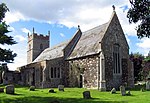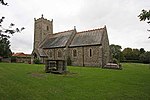Wretton SSSI
Geological Conservation Review sitesSites of Special Scientific Interest in Norfolk

Wretton SSSI is a 20.6-hectare (51-acre) geological Site of Special Scientific Interest north-east of Downham Market in Norfolk. It is a Geological Conservation Review site. This site exposes layer across the transition between the warm Ipswichian and the colder Devensian around 115,000 years ago. It has the richest assemblage of early Devensian vertebrate fossils in Britain, including arctic fox, bison and woolly rhinoceros. A footpath runs along the boundary of part of the site.
Excerpt from the Wikipedia article Wretton SSSI (License: CC BY-SA 3.0, Authors, Images).Wretton SSSI
Farhill Drove, King's Lynn and West Norfolk Wretton
Geographical coordinates (GPS) Address Nearby Places Show on map
Geographical coordinates (GPS)
| Latitude | Longitude |
|---|---|
| N 52.565 ° | E 0.483 ° |
Address
Farhill Drove
Farhill Drove
PE33 9RB King's Lynn and West Norfolk, Wretton
England, United Kingdom
Open on Google Maps







